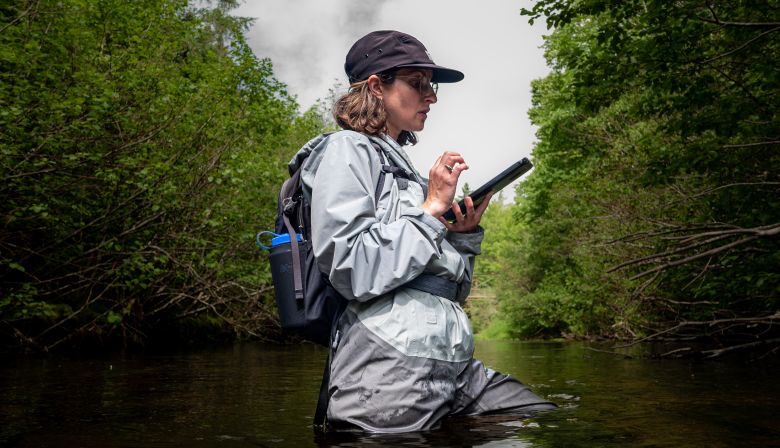
Subscribe & stay up-to-date with ASF

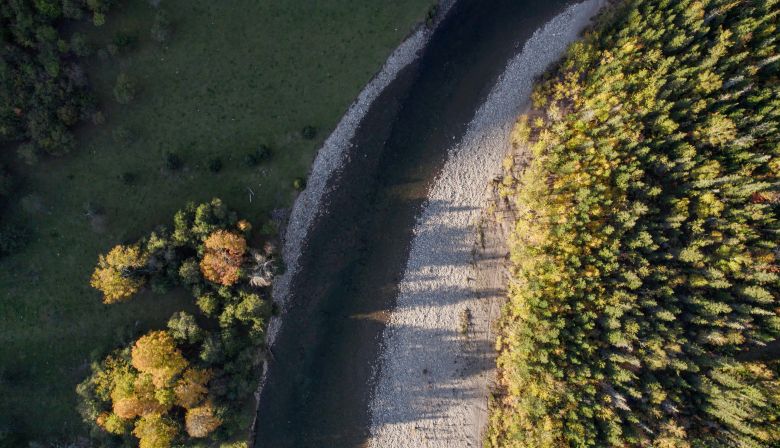
Like a magnet to iron, the Margaree River calls to fly fishers from all corners. For me, it cradles a cherished memory – the spot at Ward’s Rock where I hooked my first grilse, an event that has since fueled the flames of my fascination. Returning here wasn’t just about revisiting a place but reconnecting with an epochal moment. I found myself pulled there, not with an intent to cast a line, but to immerse myself in the serene silence and to bask in the echo of that distant memory.
Walking along the riverside towards Tent Pool on Cape Breton’s Margaree River, I found myself filled with anticipation. It had been a week since I’d bid farewell to Scotty and Kate Sherin at Quebec’s Bonaventure River. These two have become more than friends; in many ways they have become salmon angling mentors, guides who help me navigate the tricky waters of the sport and imbue me with a deep respect for their efforts to conserve Nova Scotia’s precious salmon population.
As I neared a familiar bend in the river, there was Scotty, his 13’6” 7wt two-hander carving the air with zeal. His gaze was focused – certain salmon were just one cast away.
Hearing my call, his face brightened. “Pete!” he boomed, his voice echoing across the water with his patented infectious enthusiasm. As he started to reel in his line, ready for some friendly banter, an unexpected spectacle unfolded.
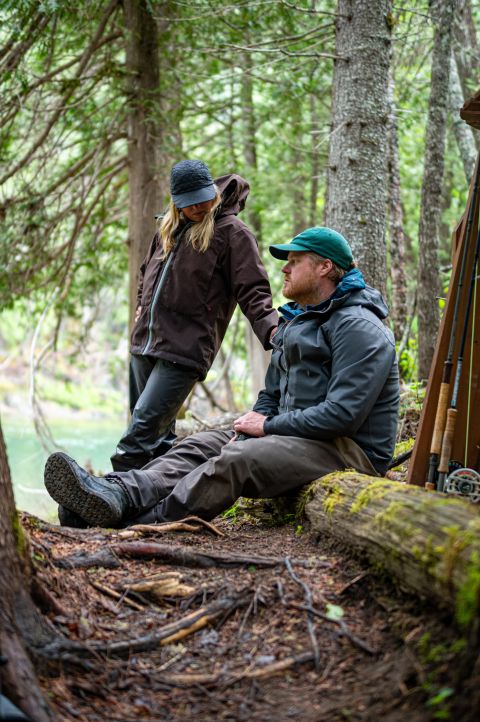
This is the quintessence of salmon fishing. It’s an art and a strategy, honed by countless hours of casting and introspection. It’s a sport where perfect casts can be overlooked and where precision can go unappreciated.
But those moments of distraction or casual conversation, that’s when the elusive salmon may choose to steal the show. It tempts, it taunts, and when you’re least ready, it lunges.
This serves as a humble reminder: while we may strive for mastery, we’re beginners at the whim of nature’s unpredictable game. In the theater of salmon fishing, we’re both the experienced actors and the awestruck audience.
Allow me to introduce two fresh faces you might bump into while fishing the Margaree: Aaron Allen and Ashley Coombs. Aaron, the new Watershed Coordinator for the Margaree Salmon Association (MSA), hails from Halifax, while Ashley, recently appointed as Field Technician, is a Sydney, N.S. native who has spent the last ten years in Halifax.
I was fortunate to be invited along on their morning expedition. They were performing a Habitat Suitability Index (HSI), a technique for assessing trout and salmon habitats in rivers and streams. The MSA has broadened its conservation efforts, marking a significant stride by bringing Aaron onboard as their first full-time employee.
For their inaugural year, Aaron and Ashley aim to complete HSIs on six or seven tributaries of the Margaree. These assessments will guide future restoration work and establish a benchmark to gauge the long-term effects of their projects.
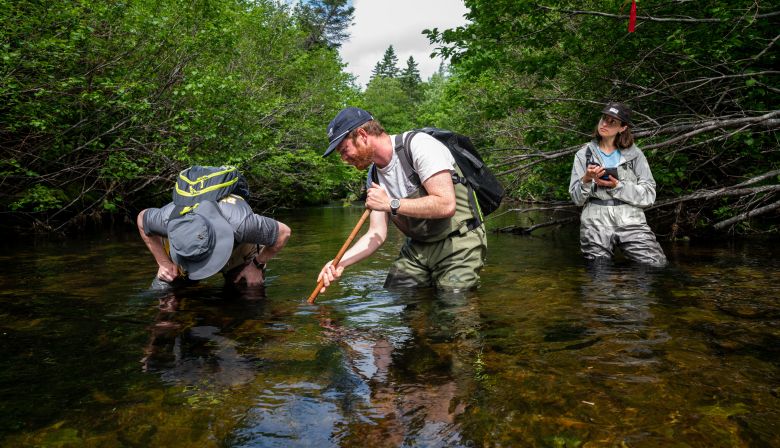

Ashley’s story is strikingly similar. Already familiar with the MSA and having longstanding friendship with Aaron, they discovered a shared interest in conservation. With family roots in Margaree, she saw this as an opportunity to “come home and give back to the backyard.” An admirer of the smallest forms of plant life, Ashley finds peace in nature’s quiet moments.
Armed with a tape measure, quadrat, tablet for data logging, metre stick, GPS, and a digital camera, this duo is all set to make their mark as the MSA’s first full-time conservation team.

Few experiences in life are as transformative and soul-stirring as witnessing first-hand the immense depth and diversity of human culture. One such opportunity presented itself when I attended a salmon ceremony hosted by the Unama’ki Institute of Natural Resources (UINR).
For many of us, products of western traditions, salmon angling signifies leisure—a recreational escape from the chaos of everyday life. Yet, for those who have inhabited the lands across North America for millennia, salmon signify something far deeper. To them, salmon are kin. Their return to our rivers marks the onset of summer and they stand as potent symbols of stability and trust.
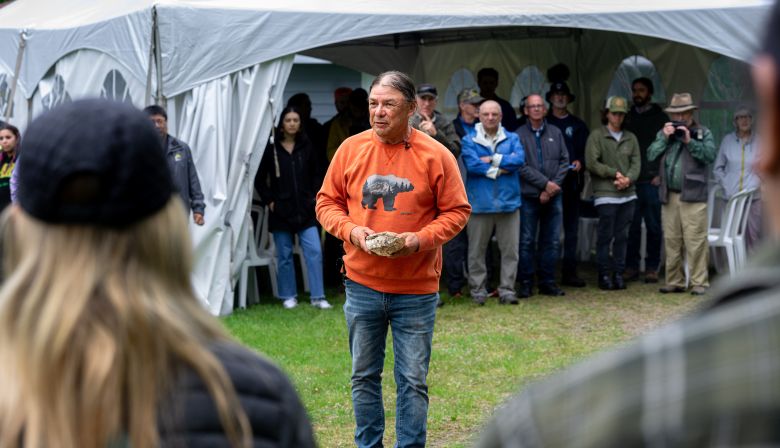
This year, nearly 130 people from diverse backgrounds had the privilege of attending this sacred event; a rare chance to connect with our roots and nourish ourselves with Atlantic salmon fresh from the river.
An elder from the Mi’kmaq community graced us with a unique blessing. Each attendee was smudged with sage and spruce, a humbling reminder of our connection with the natural world. He presented a gentle challenge: the sacred rituals were not to be photographed, at least not for purposes outside of education. His humility shone through as he imparted an implicit trust—”I know you’ll use these images to spread our message and encourage education among all people.”
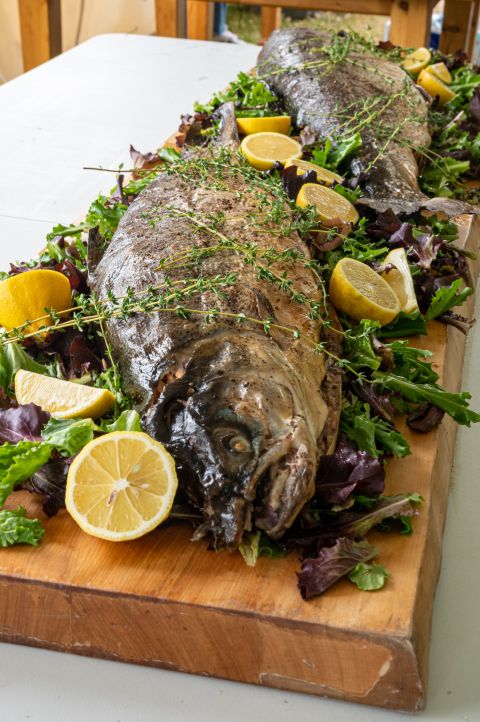
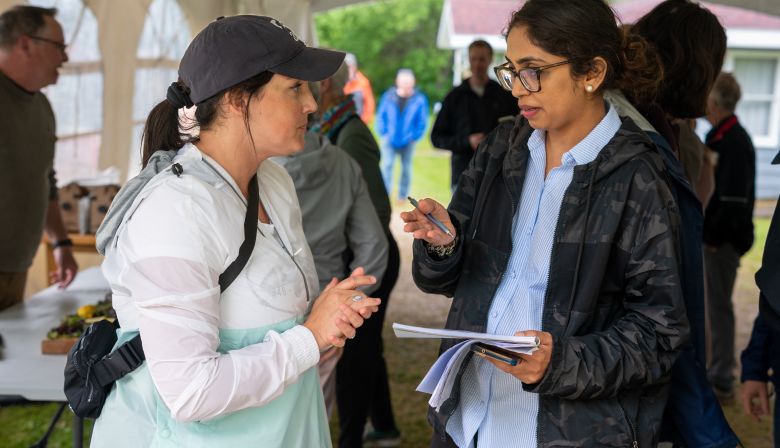
Don Ivany, ASF Program Director for Newfoundland and Labrador, Reports:
This past Canada Day weekend, as we reveled in the festivities and took to our favorite salmon rivers, we were reminded once again of the magnificence of our country. Its bountiful rivers and serene outdoors, teeming with salmon, are testaments to our natural wealth. Therefore, let’s pause for a moment to acknowledge the relentless efforts of conservation groups and volunteers across our province’s who strive to protect and restore our wild salmon stocks.
Island of Newfoundland
Earlier reports this year suggested that salmon returns to our early-run rivers in Newfoundland and Labrador (NL) seemed to be lower than the same period in previous years, a trend substantiated by the Department of Fisheries and Oceans’ (DFO) fishway reports up until June 18th. While a multitude of theories circulate about the cause of these diminished returns, the most held belief is that late ice conditions along the NL coast have delayed the salmon’s return.
Nevertheless, the picture can change dramatically within a week. Since June 25th, anglers are reporting more fish returning to our early-run rivers. Particularly in the Bay St. George Rivers, where an angler described the fishing as “on fire” on the Southwest River.

In contrast, early in the week, an angler reported poor signs of fish at Big Falls on the Upper Humber River. However, by the weekend, despite high water levels, anglers reported more fish were being hooked. Yet, due to heavy rain, the river levels have risen significantly, leading to a slowdown in fishing. In central NL, despite high water levels, fishing remains excellent, but high water temperatures may soon begin to impact success rates.
Turning our gaze towards the Great Northern Peninsula, most rivers were running at medium to high levels on June 29th. A few fish were being caught on the lower section of River of Ponds and Castor River. Unfortunately, torrential rain late last week and over the weekend caused rivers to flood, making fishing near impossible on Main River, Portland Creek, Torrent River, and Castor River. The high-water levels also led to the washout of the counting facility on Deer Arm Brook in Gros Morne Park.
On the Avalon Peninsula, rivers also experienced heavy rain, causing water levels to surge. However, according to local anglers, a good number of fish are now in the river and fishing conditions have improved.
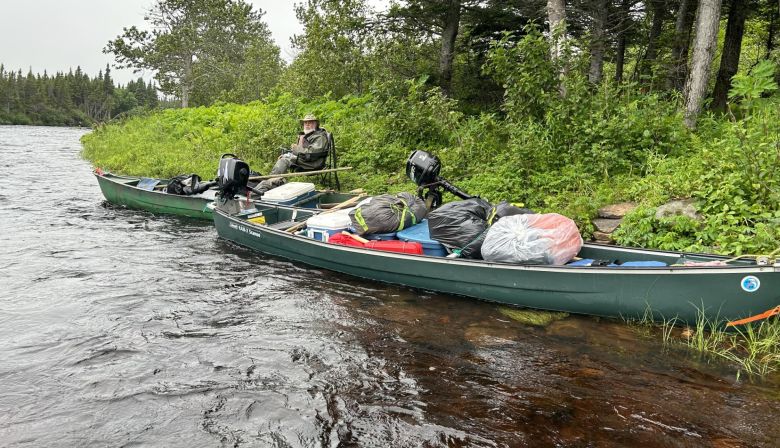
In Labrador, Dwight Lethbridge, the owner of Pratt Falls Lodge on the Eagle River, reported a late arrival of fish this year, likely due to coastal pack ice. Nevertheless, the fish are now present, and his family and friends enjoyed some productive fishing during the last week of June, hooking several large fish. Despite heavy rain causing water levels to rise quickly, guests at the lodge have been hooking a number of large fish and grilse.
The Canadian salmon fishing experience this Canada Day weekend was a tale of unexpected rains, high river levels, and the resilience of both anglers and fish alike. It underlines the need to be patient, adaptable, and ever thankful for the natural resources we enjoy.
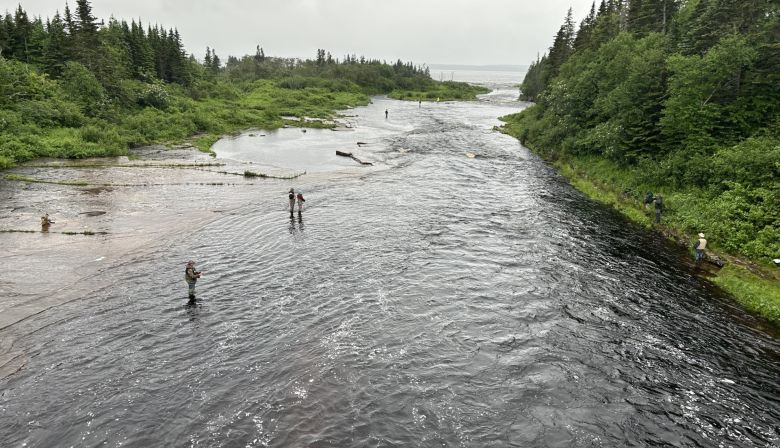
Kim Thompson, Executive Director of the Environment and Resources Management Association, Reports:
Link here
This June saw the launch of an innovative initiative on the Exploits River of Newfoundland and Labrador, the “Hooking Atlantic Salmon Recreational Anglers: Using MyCatch Mobile App” challenge. This project, the first of its kind in the country, aims to promote best practices for Atlantic salmon catch and release techniques among anglers.
The initiative leverages the MyCatch app by Angler’s Atlas, a tool commonly used for various fishing challenges. However, the twist with this initiative is its focus on promoting and showcasing the best Atlantic salmon catch and release techniques through angler-generated pictures and videos. Throughout the 2023 recreational angling season, salmon anglers are encouraged to share their best catch and release techniques, either through photos or short videos (20-30 seconds), for a chance to win prizes.
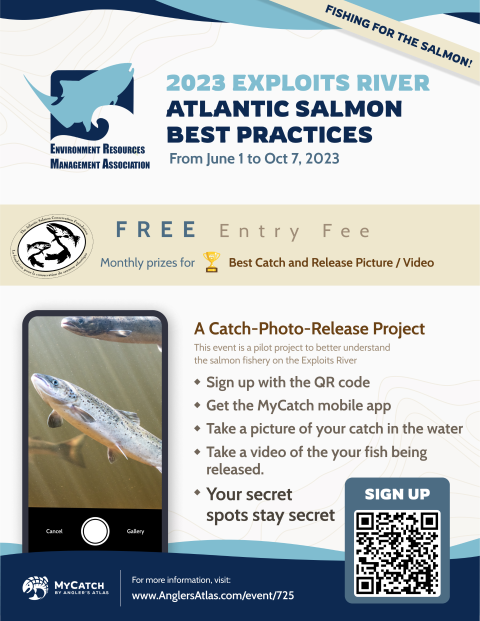
The Exploits River, known across North America for its outstanding recreational Atlantic salmon angling experiences, is the largest watershed on the island of Newfoundland. Yet, despite its fame, the Atlantic Salmon in NL is currently in a vulnerable state, with the Department of Fisheries and Oceans (DFO) classifying the Exploits River as a critical zone. The problem stems from a dearth of in-river angling data (e.g., number of fish retained and caught and released) due to a low rate of voluntarily returned angler catch records (license stub returns), which are used to compile yearly catch and effort statistics.
Traditionally, data has been gathered through cumbersome methods such as mail-out surveys, phone surveys, and website surveys. These methods only provide rough estimates of angling activity and lack detailed data, such as river-specific, seasonal, or non-target species information. The Exploits River Management Association (ERMA) understands the importance of adopting technology like the MyCatch app to support data collection efforts for a sustainable Atlantic salmon population, especially in light of 2022’s high water temperatures and low water flows on the tributaries of the Exploits River.
The MyCatch app is a free tool that allows anglers to log their fishing trips for personal use. Used in tandem with targeted angling challenges, it offers a significant improvement to annual reporting by actively involving anglers in the data collection process.
This groundbreaking project is supported by the Atlantic Salmon Conservation Foundation, Angler’s Atlas, Newfoundland and Labrador Outfitters Association, and the towns of Grand Falls-Windsor and Bishops Falls. By encouraging the adoption of best practices among anglers, this initiative hopes to contribute to the conservation and sustainability of Atlantic sSalmon in Newfoundland and Labrador.
Charles Cusson, ASF Program Quebec Director, Reports:
Read the Full Report Complete with Fish Counts, Here.
Lisez le rapport complet avec les comptes de poissons, ici.
Returns and angler success to date generally do not reflect the “normal” averages reported for this point in early July. Also, the low flows on almost all the rivers are far from ideal for anglers or the fish. We ask you to shorten your encounters with salmo as much as possible. Considering the conditions, keeping the fish in the water during the release process becomes an even more important aspect.
In this week’s report, you will find comparisons from recent years that will put into context the situation we are observing so far during the 2023 season.
River managers thank you for your cooperation in reporting your releases. The data is very important for the calculation of adjusted and actual fishing success.

En règle générale, les montaisons et le succès de pêche à ce jour ne reflètent pas les moyennes « normales » rendues au début de juillet. Également, les faibles débits sur quasiment la totalité des rivières sont loin d’être idéals. Nous vous demandons de raccourcir vos combats avec Salmo le plus possible. Tenant compte des conditions, le fait de garder le poisson dans l’eau pendant la manipulation devient un aspect encore plus important.
Vous trouverez dans le reportage de cette semaine des comparatifs des dernières années qui mettront en contexte la situation que nous observons à ce jour pendant la saison 2023.
Les gestionnaires des rivières vous remercient de votre coopération pour la déclaration de vos prises et vos remises à l’eau. Les données sont très importantes pour le calcul du succès de pêche ajusté et réel.
Les données utilisées proviennent de divers sites Web, médias sociaux et du gouvernement du Québec

Serge Collin, New Brunswick Program Director, Reports:
Restigouche – This Canada Day weekend, my wife Chantal and I joined our friends for an annual Camping trip at Mount Carleton Provincial Park, which included a little trout fishing on Camp Lake and the Little Tobique river. Sunday morning after breakfast, the group was discussing the idea of hiking Mount Bailey. Not being inclined to hiking without a fishing destination, I whispered to Chantal, ‘’you know, the Little Main of the Restigouche is only a few minutes away.” Well, I didn’t even have time to finish my sip of coffee that her camping chair was already folded and in the bag!!!
Her enthusiasm was palpable to say the least, but I never clued in that Chantal had never had the opportunity to fish the Restigouche, and knowing that such an opportunity to do so, was minutes away, there was no question that Mount Bailey would have to wait .

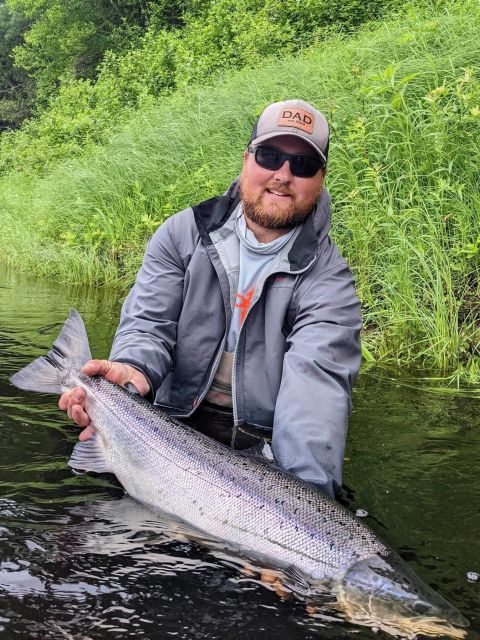
Raymond Plourde, Reports: Nova Scotia’s Margaree River featured in new fly fishing TV show
Nova Scotia’s premier salmon river, the Margaree, is lovingly profiled in a new episode of the popular fly fishing TV show The New Fly Fisher. Hosted by longtime Atlantic Salmon Journal contributor Raymond Plourde, the new show features local guides Robert Chiasson and Gioia Usher as well as ASF director and Salmon Journal field editor Charles Gaines, among others. The show is airing now on the World Fishing Network and PBS and has also just been released on YouTube.
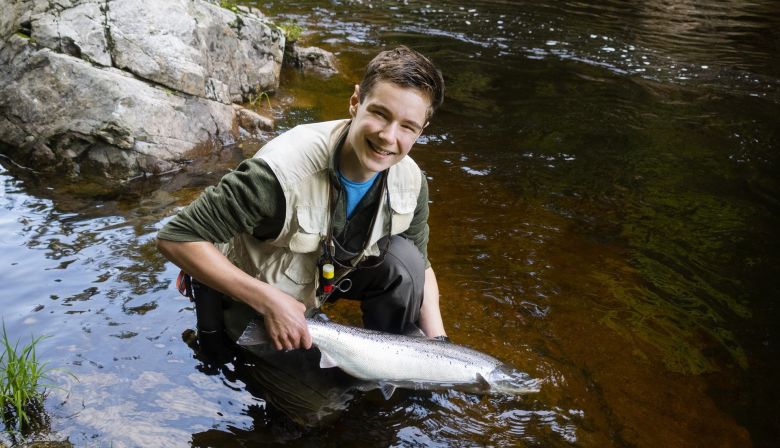
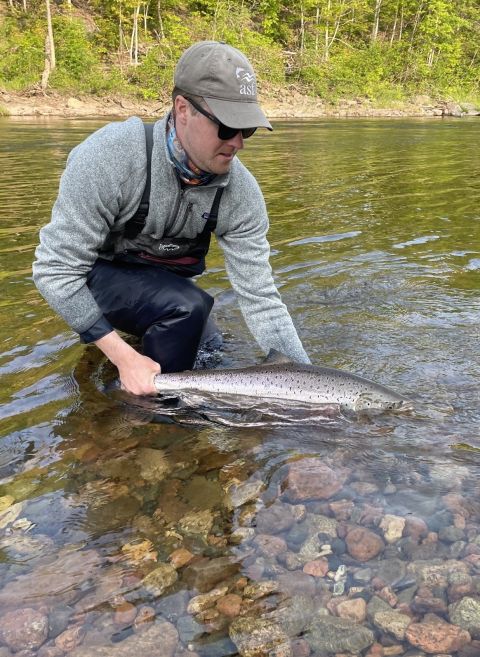
Last week, Maine was abuzz with news of the Atlantic sturgeon, a threatened species, spawning in Cobbossee Stream. This event is likely the first of its kind in over a century and is a testament to the potential for recovery. The awe-inspiring sight of fish over 10’ long spawning under the remnants of an old diner and a major state highway paints a vivid contrast to the past state of Maine’s rivers, which were once likened to open sewers.
An elderly gentleman, observing the scene next to me on the bridge, highlighted this contrast as he pointed out a sturgeon swimming beneath us. As the fish faded into the bridge’s shadow, he noted, “You know, 50 years ago, the stench from the stream on a warm day like this would have kept us indoors.” A fishing companion of mine, a self-professed ‘river rat’, recalled sneaking away on fishing trips in his youth, as the polluted river was deemed dangerous. If only his mother could see it now.
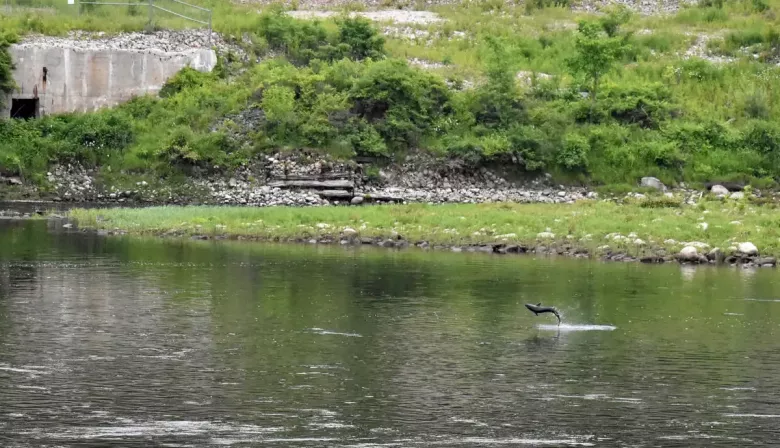
River flows continue to be high. River temperature has been running about 70F.
Trap catch has slowed down considerably for all species.
Current estimated salmon returns to the Penobscot is 1384.
Please keep in mind these are preliminary data and are subject to change. Due to river flow we are seeing a high rate of in season recaptured Atlantic Salmon that still remains to be sorted out…
Happy Fourth of July!!!